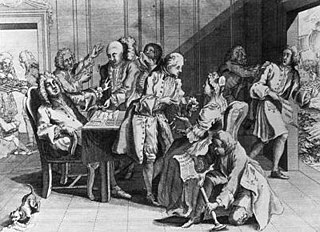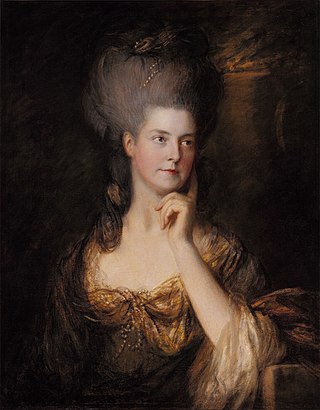Contents
Other years |
| Countries of the United Kingdom |
| Scotland |
| Sport |
| 1738 English cricket season |
Events from the year 1738 in Great Britain .
Other years |
| Countries of the United Kingdom |
| Scotland |
| Sport |
| 1738 English cricket season |
Events from the year 1738 in Great Britain .
The 1730s decade ran from January 1, 1730, to December 31, 1739.

1738 (MDCCXXXVIII) was a common year starting on Wednesday of the Gregorian calendar and a common year starting on Sunday of the Julian calendar, the 1738th year of the Common Era (CE) and Anno Domini (AD) designations, the 738th year of the 2nd millennium, the 38th year of the 18th century, and the 9th year of the 1730s decade. As of the start of 1738, the Gregorian calendar was 11 days ahead of the Julian calendar, which remained in localized use until 1923.

Robert Walpole, 1st Earl of Orford,, known between 1725 and 1742 as Sir Robert Walpole, was a British Whig politician who served as Prime Minister of Great Britain from 1721 to 1742. He also served as First Lord of the Treasury, Chancellor of the Exchequer, and Leader of the House of Commons, and is generally regarded as the de facto first prime minister of Great Britain.

William Kent was an English architect, landscape architect, painter and furniture designer of the early 18th century. He began his career as a painter, and became Principal Painter in Ordinary or court painter, but his real talent was for design in various media.

William Henry Cavendish Cavendish-Bentinck, 3rd Duke of Portland, was a British Whig and then a Tory politician during the late Georgian era. He served as chancellor of the University of Oxford (1792–1809) and as Prime Minister of Great Britain (1783) and then of the United Kingdom (1807–1809). The gap of 26 years between his two terms as prime minister is the longest of any British prime minister. He was also an ancestor of King Charles III through his great-granddaughter Cecilia Bowes-Lyon, Countess of Strathmore and Kinghorne.

Charles Townshend, 2nd Viscount Townshend, was an English Whig statesman. He served for a decade as Secretary of State for the Northern Department from 1714 to 1717 and again from 1721 to 1730. He directed British foreign policy in close collaboration with his brother-in-law, prime minister Robert Walpole. He was often known as Turnip Townshend because of his strong interest in farming turnips and his role in the British Agricultural Revolution.

Rousham House is a country house at Rousham in Oxfordshire, England. The house, which has been continuously in the ownership of one family, was built circa 1635 and remodelled by William Kent in the 18th century in a free Gothic style. Further alterations were carried out in the 19th century.

William Bentinck, 2nd Duke of Portland, styled Viscount Woodstock from 1709 to 1716 and Marquess of Titchfield from 1716 to 1726, was a British peer and politician.

Lord William George Frederick Cavendish-Scott-Bentinck, better known as Lord George Bentinck, was an English Conservative politician and racehorse owner noted for his role in unseating Sir Robert Peel over the Corn Laws.

William John Arthur Charles James Cavendish-Bentinck, 6th Duke of Portland,, known as William Cavendish-Bentinck until 1879, was a British landowner, courtier, and Conservative politician. He notably served as Master of the Horse between 1886 and 1892 and again between 1895 and 1905.

Maria, Duchess of Gloucester and Edinburgh was a member of the British royal family. She was the Countess Waldegrave from 1759 to 1766, as a result of her first marriage to James Waldegrave, 2nd Earl Waldegrave. Her second husband was Prince William Henry, Duke of Gloucester and Edinburgh, whom she married in 1766.

Margaret Cavendish Bentinck, Duchess of Portland was the richest woman in Great Britain of her time, styled Lady Margaret Harley before 1734, Duchess of Portland from 1734 to her husband's death in 1761, and Dowager Duchess of Portland from 1761 until her own death in 1785.
Events from the year 1720 in Great Britain.
Events from the year 1730 in Great Britain.
Events from the year 1731 in Great Britain.
Gentleman of the Bedchamber was a title in the Royal Household of the Kingdom of England from the 11th century, later used also in the Kingdom of Great Britain. A Lord of the Bedchamber was a courtier in the Royal Household; the term being first used in 1718. The duties of the Lords and Gentlemen of the Bedchamber originally consisted of assisting the monarch with dressing, waiting on him when he ate, guarding access to his bedchamber and closet and providing companionship. Such functions became less important over time, but provided proximity to the monarch; the holders were thus trusted confidants and often extremely powerful. The offices were in the gift of The Crown and were originally sworn by Royal Warrant directed to the Lord Chamberlain.

James Cornwallis, 4th Earl Cornwallis was a British clergyman and peer.

George Augustus Frederick Cavendish-BentinckPC JP, known as George Bentinck and scored in cricket as GAFC Bentinck, was a British barrister, Conservative politician, and cricketer. A member of parliament from 1859 to 1891, he served under Benjamin Disraeli as Parliamentary Secretary to the Board of Trade from 1874 to 1875 and as Judge Advocate General from 1875 to 1880.

Thomas Pellow, son of Thomas Pellow of Penryn and his wife Elizabeth, was a Cornish author best known for the extensive captivity narrative entitled The History of the Long Captivity and Adventures of Thomas Pellow in South-Barbary. Pellow's book chronicles his many adventures spent during his 23-year-long captivity giving a detailed account of his capture by Barbary pirates, his experiences as a slave under Sultan Moulay Ismail, and his final escape from Morocco back to his Cornish origins.
William George Cavendish-Bentinck, was a member of parliament for Penryn and Falmouth between 1886 and 1895, who married into the American Livingston family.